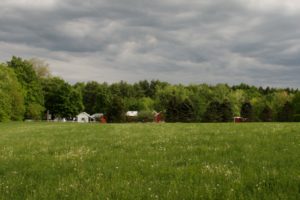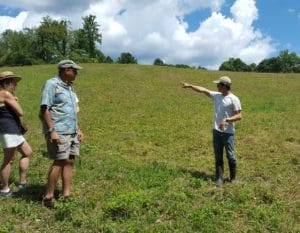The Basics of Impact Investors: What a Farmer Needs to Know
A primer for working with an impact investor focused on farmland access.
Small farmers and small farm advocates have probably heard statistics about average farmer age (nearly 60 years according to the USDA) and young farmer land access issues (68% of farmers cite land access as the biggest obstacle for young and beginning farmers according to the National Younger Farmers Coalition). In response to these problems you may have also seen a rise in the number of “impact investors” focused on helping farmers with land access.
The goal of this article is to provide a basic background on these investors and prepare farmers for interactions with these groups. Please be aware that the services or products offered by these investor groups may not be helpful or the best option for many farmers. Contrastingly, it may also be the perfect situation for another farmer. I view understanding these options as having another arrow in the quiver (or seed in the ground) to be used if needed, and when appropriate.
Full disclosure: I manage one of these entities, called Local Farms Fund, a community investment fund that pools individual investors together to provide lease-to-own arrangements to early stage farmers in the NY Foodshed. In this article, I am speaking from my personal experience in this field. In this context, I am also trying to represent the impact investor universe as whole, but cannot speak specifically on behalf of the other people or organizations providing similar land access opportunities.

Featherbed Farm (Saratoga County, NY), Local Farms Fund’s first investment (photo provided by Local Farms Fund)
Let’s start with a basic primer. What is “impact investing?” According to a simple Google search, impact investing refers to investments made into companies, organizations, and funds with the intention to generate a measurable, beneficial social or environmental impact alongside a financial return. I would add that impact investing generally also means investing in private entities that have a targeted positive social or environmental impact. This difference is exemplified by a hypothetical, publicly traded solar panel company. That solar company’s output may have a measurable environmental impact, but it is not necessarily formed or operated for the purpose of reducing greenhouse gases. Intention takes impact a step beyond the positive outcomes. I also think it is important to note the word “investing” is in the title and “financial return” is in the definition. Impact investing is very different from philanthropy. Folks working with an impact investor should fully understand impact investing is not charity. Investors are expecting to receive money back and make money from the investment. This return may not always be significant, but the intention is to make money while creating the positive impacts.
Another common term you will hear is “Due Diligence.” According to the Merriam family and Mr. Webster, due diligence is research and analysis of a company or organization done in preparation for a business transaction. Due diligence is really a fancy word for research.
A final primer item to note is that impact investors can take all sorts of shapes and sizes. Impact investors may include an individual, multiple individuals, a family, multiple families, angel investors, an angel network, a fund, a company, a non-profit, the government or any other legal formation / identity under the sun. Unfortunately, we do not have time to go into the specific details on each type of structure, but, as will be noted later, knowing who or what you are dealing with is extremely important.
In trying to summarize how to work with impact investors, I boiled my thoughts down to five basic guidelines: know yourself, create a business plan, review your options, assess the fit and reverse the due diligence.
Know Yourself.
If you cannot articulate what you want, another person is not going to be able help. Any farmer should assess his or her own personal goals as well as his or her own personal situation. Understanding “Where am I now?” and “Where do I want to be?” is a critical first step. Going down this path will quickly lead into a personal plan to get from A to B. Throughout this process it is important to be thinking about optimal versus acceptable and desires versus needs. When reviewing farmland access options, it is unlikely that an optimal situation will arise. Maybe a farmer wants a business focused 50/50 on vegetable production and pastured meat production. What if the farm is better suited for a 30/70 split? Is that still acceptable? This thought process and evaluation should expand one’s horizons and ultimately help lead to a satisfactory outcome.

Chad Williams talking about his pastures at HoneyMade Farm (Columbia County, NY), Local Farms Fund’s second investment (photo provided by Local Farms Fund).
The first step in working with an impact investor is generally going to be verbally articulating your plans. This is how I initially differentiate between Local Farms Fund farmer candidates. I can usually tell from the first conversation whether there is potential with a farmer. Knowing yourself will make you prepared for this first conversation.
Create a Business Plan.
I cannot stress this enough. Farming is an occupation and a farm is a business. It is unlikely that impact investors will be interested in working with a person that does not take that perspective. A business plan should demonstrate the qualities of the business you want to run, you as a person and the financial merits of the operation. Even if you do not know exactly what the farm will look like, creating a business plan will assist the process of “knowing yourself.” Creating a business plan forces the writer to think about oneself as both a person and an entrepreneur. I also note it is much easier to alter a business plan than it is to create one from scratch. If you have a plan modeled on an enterprise that is producing vegetables on 2 acres and raising 300 layer hens it should be fairly quick to expand that to production on 4 acres and 600 hens. Having the plan established ahead of time will allow you to be better informed and react quicker to unplanned opportunities that may arise. I can almost guarantee an impact investor will ask for your business plan. If they do not ask for a business plan, I would actually be a little suspect of their motives. Being ready ahead of time will help you pass this essential due diligence hurdle—business review. About 50% of the due diligence process with Local Farms Fund focuses on understanding the business plan and assessing the farmer’s understanding of his or her plan.
Review Your Options.
Ultimately the right path for any farmer is going to be driven by both the personal situation and business goals. Generally this takes one of two options—buy or lease—although frequently with impact investors these options are interconnected via a purchase option or lease-to-own arrangement. Every option has both positive and negative factors and, unfortunately, some of the decision process may be dictated by one’s financial situation. Knowing your numbers will make this process easier since it will help you understand whether your goals are financially feasible. This concept also pertains to seeking and asking about alternative options. Do not assume that you cannot own a farm right away or that leasing is the best option, unless you have actually reviewed what is available. This means talking to all the different investment groups. Each investment group is going to have small (and sometimes significant) variations in how it operates. In certain situations, I know that Local Farms Fund will not be the right fit for a given farmer even if I would be interested in working with the farmer
Assess the Fit.
As noted earlier, every party will have different goals, processes and structures. Understanding these variances can be the difference between a successful, happy relationship and an unsuccessful, unhappy relationship. What is the process of working with a land access partner (steps, timing, costs)? What is the philosophy or motivation of the impact investing entity? Where is the money coming from? Could the source of funding impact the relationship? Does the model offered fit your plans? Can it be altered?
Note that farmland access may not always equal affordability. Understanding this trade-off may be helpful in your decision process. Does the group provide other services? If you require or desire other services it will be important to know from where those are going to come. Ultimately a large part of figuring out if the partner is good is going to be one’s gut reaction. Do you get the “right feeling” from this potential partner?
Reverse the Due Diligence.
I can almost say with 100% certainty that any impact investor is going ask a lot questions. They are doing due diligence on their potential investment. Any farmer going through this process has the right to ask as many questions in return as he or she deems appropriate. This is the main way you are going to be able to properly and fully assess the fit of a potential partner. I note that this section could also be titled “Ask Questions,” as more broadly a farmer should realize that nearly everything is negotiable in some way shape or form. Ask if they can change the deal to make it work better for you. After all if they truly are an impact investor, their goal should be to make something work for you within a reasonable set of boundaries.
When I get these kinds of questions on Local Farms Fund, it actually creates more reassurance that this is the right farmer. I know that farmers asking the tough questions are thinking about all the options and carefully reviewing the situation. I want to partner with somebody focusing on all the details.
I completely realize this adds additional complexity into an already complex, risky and time-consuming process. The good news is much of the work needed for working with impact investors is part of being a good business manager. I generally find that the farmers that can answer all my questions well, and in a timely manner, are the ones that I think have the best chance for success, with or without an impact investment group providing land access.
Local Farms Fund
Local Farms Fund is a community impact farmland investment fund that supports young and early-stage farmers in the NY Foodshed with secure land access. The Fund provides sustainable farmers with lease-to-own arrangements on farm properties in the states connected to the NYC metropolitan area, the NY Foodshed—with a focus on the Hudson Valley. This model, using Slow Money principles, delivers positive social (farm business & community development) and environmental (sustainable agriculture) impacts while generating modest financial returns for the investors. Local Farms Fund is open to all investors in the NYC tri-state area (NY, NJ, CT) looking to have a positive impact on the local farming community and beginning farmers, while also achieving a modest investment return.


Dear Organic Farms,
Can I meet with someone, and is there anyway for them to invest in land for my Farm, or do you know of any land that can support my Farm?
Look forward to hearing back from you shortly.